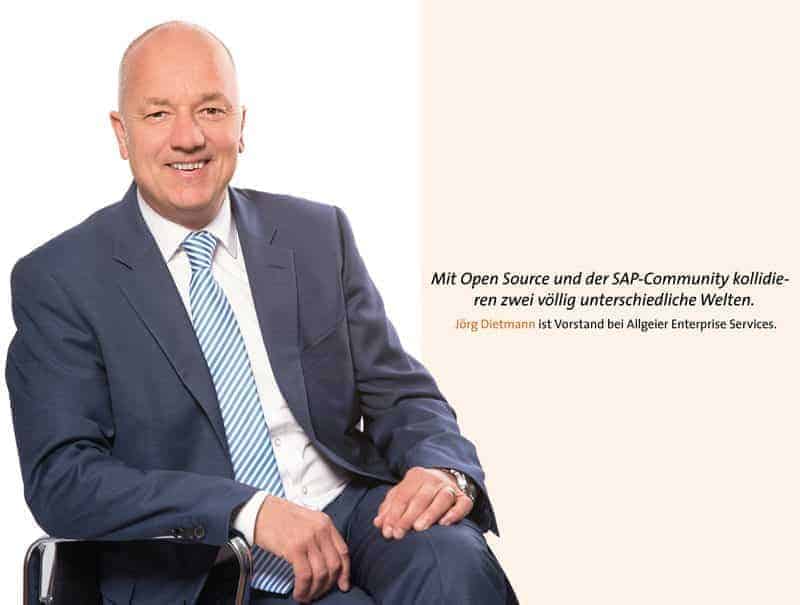Gut feeling and Big Data


Do you need the Hana Cloud Platform for IoT or are there also on-premise solutions? What are the advantages and disadvantages of cloud computing here?
Jörg Dietmann: In this context, you mean the SAP Cloud Platform, which has conceptually replaced the Hana Cloud Platform.
As just explained, there are options for both areas here. SAP is pushing the cloud solution because of its much more powerful device management.
The advantage in terms of connecting IoT scenarios via the SAP Cloud Platform is that, on the one hand, access can be made from anywhere, since it is in the cloud, and, on the other hand, preconfigured scenarios are available to make IoT data available via Vora for your own applications, since you want to avoid loading the large amount of data from the IoT scenarios into your own S/4 database. We have not yet been able to identify any disadvantages.
From Allgeier's point of view: What are the current advantages and disadvantages of HEC/HCP? What should still change or improve?
Dietman: SAP is continuously working on improving the standard solutions provided in the SAP Cloud Platform. A more detailed forward-looking pipeline for us as a partner would be desirable. The HEC is not relevant for us as a cloud and data center service provider.
SAP has renamed and combined their cloud offering from HCP, HEC etc. into SAP Cloud - sounds a bit like: the cloud is dead, long live the cloud -, doesn't it?
Dietman: This is not quite correct. Only the Hana Cloud Platform was renamed to the SAP Cloud Platform, the HEC (Hana Enterprise Cloud) still represents a separate technology platform.
SAP's intention may be to better position the Cloud Platform according to its functionality. It is still possible to use the Hana database here, but many other scenarios, interfaces and applications do not require a database at all.
So no, the cloud is not dead, rather the opposite, this will become SAP's central and agile cloud hub.
In addition to the cloud security risks that affect all providers, how are SAP's existing customers taking SAP cloud pricing - subscription? AWS, Azure and Google are almost always cheaper, right?
Dietman: Well, a classic outsourcing operator is subject to the same security risks as the cloud scenarios offered by Allgeier or SAP. At the end of the day, there is a data center somewhere with hardware, firewalls and Internet connections that need to be protected accordingly.
However, this is now a standard that is well mastered in our IT services industry. It remains exciting to see how this will develop and whether this model will become established for Europe or is intended more for the American market.
Hana and open source Hadoop seem to be a winning pair: How do you see this partnership at Allgeier?
Dietman: With Hana, SAP has created a new platform with which resource-intensive questions can be answered in real time for the first time - Hadoop and the Apache Big Data ecosystem have grown out of a different motivation, here it is primarily a matter of processing very large volumes of data first.
The combination of these two worlds now allows customers to address incredible amounts of data and use it to drive their business; gut instinct becomes statistically proven, machine-assisted decisions.
The linking of Hadoop and SAP thus results in enormous strategic potential: The ability to process huge amounts of data that the Hadoop ecosystem brings with it combines with the integrated process landscape of an SAP system.
This makes it possible to implement the benefits of Big Data more quickly in all relevant processes and thus create real added value.
And what tasks can be solved with it?
Dietman: Hadoop is often seen as a cheap mass storage for unstructured data, but the Hadoop ecosystem has much more to offer: From structuring this raw data to refining it to predicting future events, the sky's the limit here.
And this is where S/4 Hana comes into play: As SAP's new real-time platform, critical business decisions can be made centrally here and all the data for this decision can also be used - moving away from reacting to anticipating upcoming developments and preparing decisions using statistical methods.
Is there a specific Hana/Hadoop offering from Allgeier?
Dietmann: Basically, Allgeier has a large number of Hana experts and, with MGM, also has one of the leading Big Data consulting teams on board.
The challenge now is to bring these two teams of experts together to unlock opportunities for customers. With joint teams, we are at several customers to test Hana Vora as an interface between the two worlds; here, too, we are in close exchange with SAP to incorporate our customers' requirements into future product releases.
With Linux as the basis for Hana, with Hadoop, OpenStack, Cloud Foundry, and more, open source know-how is necessary among SAP's existing customers : Where does the SAP community stand? Is the knowledge about these open source products available? Where and how does Allgeier help?
Dietman: With open source and the SAP community, two completely different worlds collide. On the one hand, there are applications with regulated release cycles and structured maintenance and support processes. On the other hand, there are community-driven projects, most of which grow dynamically and are difficult to anticipate in terms of their lifespan.
This is where many of our customers lack the "enterprise ready" stamp, a partner who can evaluate and provide long-term support for maintenance and interoperability of the various components.
A very interesting Hana/Hadoop use case is predictive analytics: what does Allgeier offer for this?
Dietmann: Allgeier covers SAP's entire predictive analytics portfolio and has already experienced its extensive benefits and minor weaknesses in many projects.
However, Allgeier sees itself here not only as a purely technical implementation partner. We want to help our customers to be able to use these tools and techniques in terms of content and the power of the algorithms behind them. To this end, we bring along our own experts in the field of data science and machine learning.
From Predictive Analysis it might not be far to Machine/Deep Learning, are there already considerations for these AI concepts at Allgeier?
Dietman: Allgeier has been active in this environment for some time, particularly through its Big Data expertise with MGM, and has gained a great deal of experience in the area of text mining, i.e., the extraction of information from large quantities of unstructured texts.
SAP has also built up an extensive Machine Learning offering in recent years and provides many of the most useful standard algorithms in this area.
However, we still see a need for SAP to catch up, particularly in the area of deep learning. This involves large neural networks that recognize complex patterns on the basis of millions of data records and constantly improve themselves.
These enable the kind of artificial intelligence that everyone is talking about in autonomous driving, for example. We are still a long way from out-of-the-box AI here.
What role and significance does the version change to S/4 play in the Allgeier offering? From Allgeier's perspective, how far along is the SAP community in adapting to S/4? Where do the existing customers stand?
Dietman: The introduction of S/4 changes a lot in the existing SAP landscape. A lot of old habits are being cut and there is a large amount of simplification and sensible innovations.
However, this generational change is only just beginning. Our customers recognize this potential, but they also know how much preparatory work in the area of digital transformation is still necessary in their company in order to really use the possibilities of an S/4 system profitably.
Last year, DSAG CEO Marco Lenck said that the latest software from Walldorf is not necessarily needed to master the digital transformation: Will the transformation also succeed with Business Suite 7? What is the opinion at Allgeier?
Dietman: The current version of the Business Suite certainly offers our customers a proven, clearly structured solution for their existing workflows and processes.
However, if you want to manage the truly in-depth and efficient implementation of predictive analytics and thus the transition to a data-driven enterprise, you need a leaner, more efficient system that directly integrates these capabilities natively. To achieve this, a move to S/4 Hana will certainly become inevitable at some point.
What do you see as the key areas of focus in the SAP community over the next twelve months?
Dietmann: Now that Hana has established itself in many companies over the last two years, the task is to translate its strengths into direct competitive advantages and more efficient processes.
The topic of S/4 will now become more relevant, after the response last year was still rather restrained. It will be interesting to see what experiences the early adopters have with the new system.
And a big focus will certainly be on Big Data integration into existing SAP landscapes through offerings like Hana Vora.







